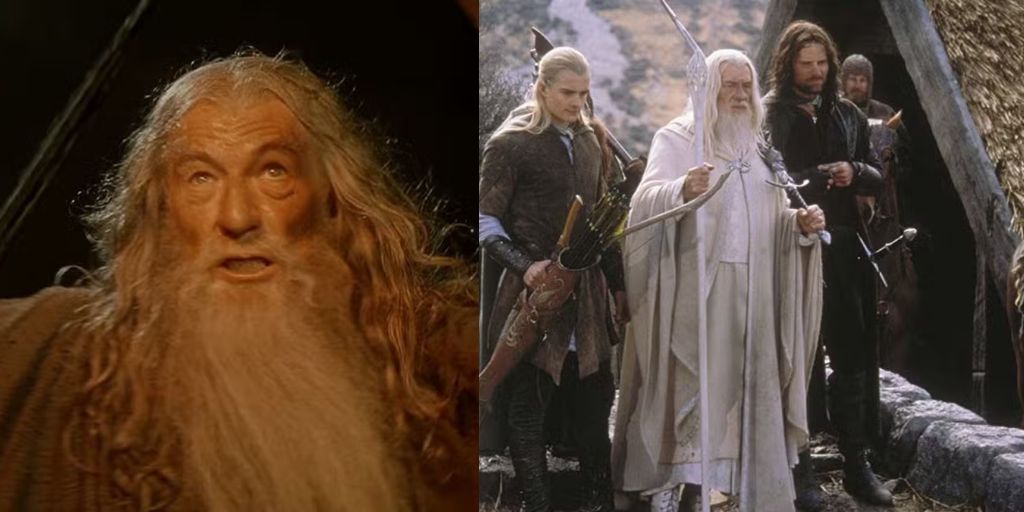J.R.R. Tolkien’s The Lord of the Rings has held a special place in readers’ hearts for decades, offering a world of deep characters, complex histories, and profound moral questions. Among the most iconic characters is Gandalf, played by Ian McKellen in the films. Gandalf is not only a powerful wizard but also a key figure in the struggle against Sauron, the dark lord of Middle-earth.
However, Gandalf stands out as more than just a typical sorcerer. As a Maia, he belongs to a unique category of beings called the Ainur, who existed before the world was even formed. Unlike typical mortals, Gandalf is an immortal spirit with powers and insights that go far beyond human understanding.
Yet despite his otherworldly origins, he relies on a simple wooden staff to channel his magic. This brings up a curious question: why would someone as powerful as Gandalf need a staff?
The answer goes beyond just Gandalf’s abilities as a Maia. It ties into his mission and the restrictions imposed on him by the higher beings called the Valar when he was sent to Middle-earth. Gandalf’s staff is much more than a magical instrument; it is a symbol of his authority, a guide for his mission, and a tool for controlling his powers within the limits he must respect.
This restraint reflects how Tolkien designed his world, combining strength with responsibility. Gandalf’s staff not only serves as a tool for magic but represents the balance he must keep between his powers and his duties. By examining Gandalf’s background, mission, and the role of his staff, we can see why he must rely on it in his interactions with the world of Middle-earth.
Gandalf’s Role in the Istari and the Staff’s Symbolic Power
Gandalf’s background as a Maia sets him apart from typical wizards in fantasy. As a Maia, Gandalf is a lesser Ainu, a type of divine being created by Eru Ilúvatar, the god figure in Tolkien’s legendarium. Among these beings, the most powerful are the Valar, who shape and guide the world, while the Maiar serve them as helpers and messengers. Gandalf is one of these Maiar, which places him in a unique role.
He is both powerful and deeply aware of the responsibilities that come with such strength. When the Valar chose to send a group of Maiar to Middle-earth to counter the growing threat of Sauron, they created the order of the Istari or wizards.
The Valar selected five Maiar to take on physical forms, including Gandalf. Unlike Sauron, who sought control and dominance, Gandalf’s mission was to guide and inspire hope in the people of Middle-earth.
The Istari came to Middle-earth not as conquerors but as wise counselors, entrusted with helping the free peoples resist Sauron’s influence. However, they were given strict rules. Tolkien’s The Silmarillion describes how the Valar instructed the Istari to avoid displays of overwhelming power, which could intimidate or control the very beings they were meant to guide.
Instead, they were meant to influence through wisdom, encouraging people to stand up to Sauron on their own terms. This approach set the Istari apart from Sauron, whose power was rooted in manipulation and domination. Gandalf, then, embodies the spirit of gentle guidance, focusing on the freedom of choice for Middle-earth’s inhabitants. His staff plays an important role in allowing him to fulfill this role without resorting to force.

Gandalf’s Staff as a Channel for Limited Power
While Gandalf has significant power, he cannot wield it in the same way he could before taking on a mortal form. His staff helps him channel his abilities within the limitations set by the Valar. Rather than unleashing his full power, which might disrupt the world or instill fear, Gandalf’s staff allows him to use his magic in more measured, focused ways.
In his physical form, Gandalf faces the same challenges and vulnerabilities as other mortals, and the staff aids him in maintaining control over his magic without overwhelming the world. Gandalf’s staff is essential for creating the balance between his divine powers and the physical limits he must adhere to.
In Tolkien’s world, magic comes with its own risks and responsibilities. Power must be used thoughtfully, with respect for the well-being and freedom of others. Gandalf’s staff represents this careful approach to magic, helping him work within the world’s natural limits rather than overpowering it.
Tolkien’s fascination with mythology and the archetype of the wise, restrained wizard influenced his portrayal of Gandalf and his staff. Wizards in ancient folklore often carry staffs as symbols of their wisdom and authority, and Gandalf is no different. His staff is both a tool and a part of who he is, shaping how he interacts with Middle-earth.
The Staff’s Role in Gandalf’s Character Transformation
As Gandalf grows and takes on greater responsibilities, his staff remains a constant, symbolizing his authority and purpose. When Gandalf transforms from “Gandalf the Grey” to “Gandalf the White,” he returns to Middle-earth with even greater power and a renewed mission.
After defeating the Balrog and experiencing a kind of resurrection, Gandalf’s powers are amplified, but so are his responsibilities. In his new role as Gandalf the White, he becomes the leader of the Istari, taking over from Saruman, who had succumbed to corruption.
This transformation is visually represented in the films when Gandalf breaks Saruman’s staff at Isengard, symbolizing his rise in authority. Breaking Saruman’s staff is a pivotal moment, both in the story and for Gandalf’s character. It signals his new role as head of the Istari and marks his shift from a guide to a more direct protector of Middle-earth.
Gandalf’s transformation is not only about gaining power but about embracing a new level of responsibility. As Gandalf the White, he becomes more assertive in his mission, using his staff to confront Saruman and protect Middle-earth more actively. His return as Gandalf the White underscores the importance of his staff as a tool for guidance and balance, not simply a weapon.
Without his staff, Gandalf would be incomplete—not because he lacks power, but because the staff is essential for expressing his authority and fulfilling his role. Tolkien’s concept of magic in Middle-earth is not one of unchecked power but of carefully balanced responsibility.

Gandalf’s Staff in the Context of Middle-earth’s Power System
Magic in Tolkien’s world is a unique force that reflects the values and limitations of its user. Rather than an unlimited source of energy, magic in Middle-earth is tied to the user’s wisdom, intent, and moral compass. Gandalf’s staff reflects this view of magic as something that should be used carefully and with respect for others.
Gandalf’s staff is not only a symbol of his authority but also an instrument that allows him to balance his power with the needs of the world around him. His staff acts as a channel for his abilities, helping him focus his magic and maintain control without overwhelming others.
In Middle-earth, many characters have objects that symbolize their roles, from Aragorn’s sword Andúril to the One Ring. These items reflect their users’ unique responsibilities and place in the world, and Gandalf’s staff is no exception.
Tolkien’s portrayal of Gandalf’s staff aligns with his broader philosophy of magic and power. In Middle-earth, strength is not just about raw force but about the responsibility to use power wisely. Gandalf’s staff is a reminder that even the most powerful beings have limits and must act with respect for the world and its inhabitants.
This theme of balanced power runs through many of Tolkien’s works, reflecting his view of authority as something that should be exercised with restraint and wisdom.
Gandalf’s Journey in The Rings of Power
In Amazon’s The Rings of Power, a character known as The Stranger, played by Daniel Weyman, offers viewers a new perspective on Gandalf’s story. The Stranger, later revealed to be Gandalf, arrives in Middle-earth with little memory of his identity.
As he gradually regains his sense of self, he discovers his powers and begins to understand his purpose. In season 2, The Stranger goes on a journey to find a staff, recognizing that he needs it to control his abilities more effectively. Without it, he struggles to manage his magic, sometimes endangering his friends, the Harfoots Nori and Poppy.
This storyline gives insight into Gandalf’s development and the importance of his staff in his journey. It shows that the staff is more than just a tool for magic; it’s an essential part of his identity and role as a guide.
As The Stranger searches for a staff, viewers get a look into Gandalf’s transformation into the wise, powerful figure he will become. The search for the staff symbolizes his need to balance his powers and understand his role in Middle-earth, reinforcing Tolkien’s theme of magic as a force that must be used with care.
The Symbolic Meaning of Gandalf’s Staff in Tolkien’s World
Gandalf’s staff embodies his mission and values, reflecting Tolkien’s approach to magic and power. In Middle-earth, magic is not a tool for domination but a way to promote balance and harmony. Gandalf’s staff is a symbol of his commitment to this philosophy, helping him channel his abilities within the limits he must respect.
In a world where power can easily corrupt, Gandalf’s staff reminds him of his duty to guide, not control. This focus on balanced power is a core aspect of Tolkien’s work, reflecting his belief that authority should be tempered with responsibility.
Through Gandalf’s journey, Tolkien reveals the idea that true strength comes from restraint, compassion, and respect for others. Gandalf’s staff serves as a reminder that power is not an end in itself but a tool for fulfilling one’s responsibilities.
In The Lord of the Rings, Gandalf’s staff represents the balance he must maintain as both a powerful being and a guide. It is a symbol of his mission to protect Middle-earth while respecting the freedom of its inhabitants. Gandalf’s story is one of growth, humility, and dedication, and his staff is a vital part of that journey.


















